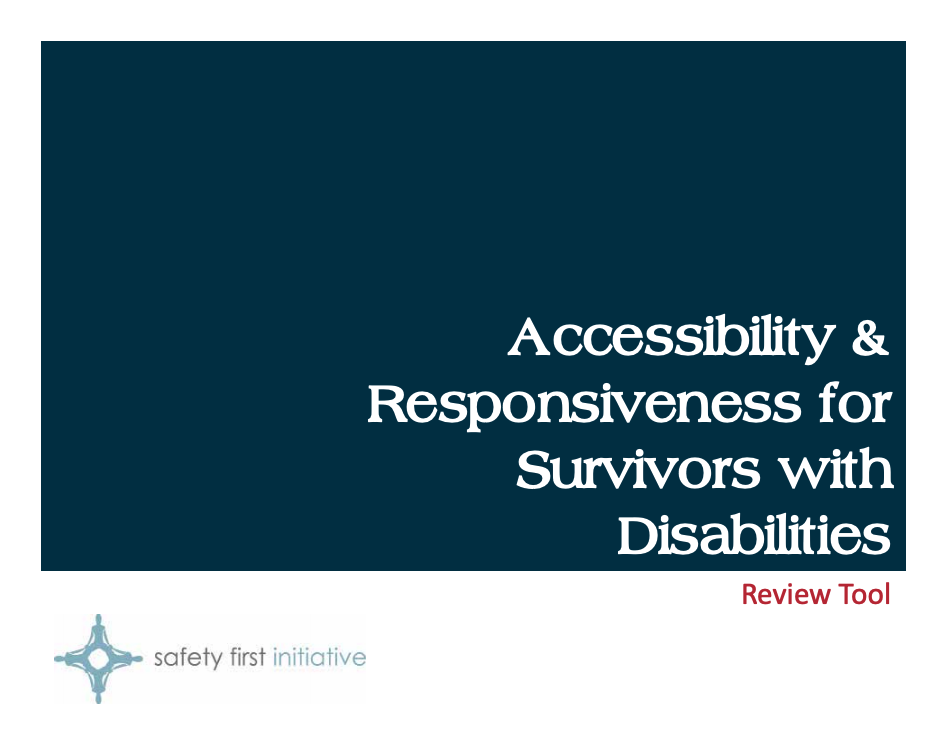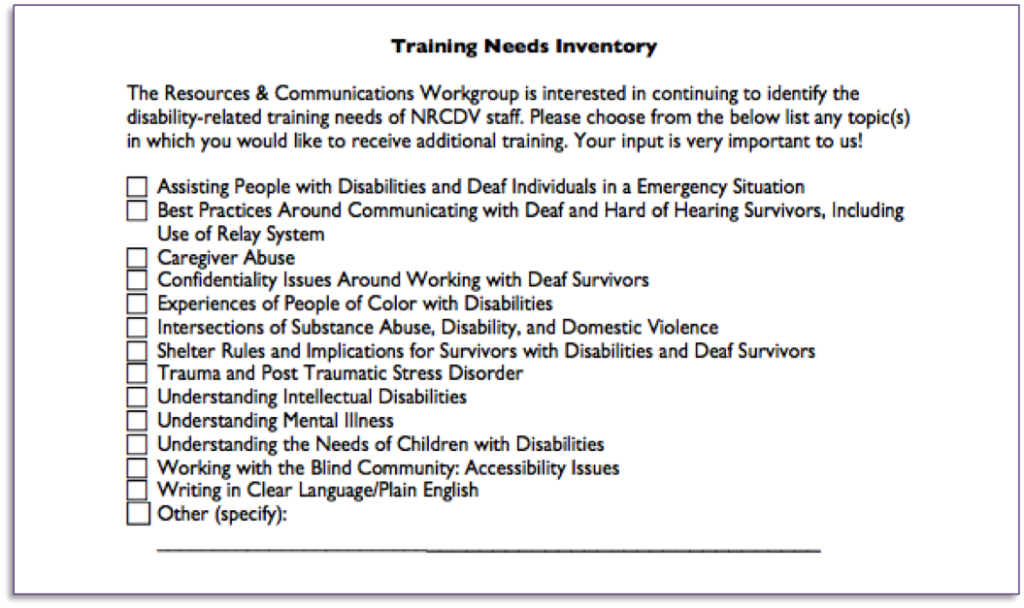 The scope of the Access Initiative was broad, and efforts were made by NRCDV staff to address accessibility across several main areas, including organizational practices and policies, the physical environment, communication processes, as well as capacity building. This section highlights some of the key activities and accomplishments of the NRCDV Access Initiative in several domains as outlined by the Accessibility Responsiveness Review Tool developed by the Safety First Initiative in Kansas City, MO. This Tool provides a framework for domestic violence, sexual violence, and disability service organizations to think about the “who, what, where, when, why and how” of providing inclusive, accessible, and responsive services.
The scope of the Access Initiative was broad, and efforts were made by NRCDV staff to address accessibility across several main areas, including organizational practices and policies, the physical environment, communication processes, as well as capacity building. This section highlights some of the key activities and accomplishments of the NRCDV Access Initiative in several domains as outlined by the Accessibility Responsiveness Review Tool developed by the Safety First Initiative in Kansas City, MO. This Tool provides a framework for domestic violence, sexual violence, and disability service organizations to think about the “who, what, where, when, why and how” of providing inclusive, accessible, and responsive services.
As the efforts undertaken by the NRCDV Access Initiative illustrate, accessibility means much more than meeting the legal requirements of the Americans with Disabilities Act. It reflects and shapes an organization’s practices, policies and overall culture. Moreover, working towards accessibility is an ongoing process requiring continuous self-assessments and critical thinking, as well as individual and organizational commitment and willingness to change.
Accomplishments:
 The NRCDV provided staff with information about the ADA rights available to employees with disabilities. Staff became aware of their options related to disclosure and reasonable accommodation.
The NRCDV provided staff with information about the ADA rights available to employees with disabilities. Staff became aware of their options related to disclosure and reasonable accommodation.- The NRCDV invited the Disability Rights Network of Pennsylvania (DRN) and two area Emergency Medical Services teams to conduct a physical assessment of our office space. As a result, new language pertaining to assisting people with disabilities in safely exiting the building in the case of an emergency was incorporated into the office-wide Emergency Evacuation Plan:
When possible, assistance should be given to persons with disabilities and/or impairments. If an employee has not disclosed their disability and/or impairment, but requires assistance during an evacuation, they should immediately ask the nearest staff person for help. For individuals with a disability and/or impairment, the requested “buddy system” is suggested as an advanced means of creating a plan to assist that person.
Accomplishments:
- As an effort to make our communication processes more inclusive and accessible to people with and without disabilities, a small workgroup of the Access Initiative developed the Standards for Written Products of the NRCDV, which is an internal procedure for creating accessible, clear, reader-friendly documents that are consistent across the NRCDV. These rules are based on APA style guidelines and universal accessibility rules for clear language/plain English.
- NRCDV staff received training on the use of assistive technology, provided by the local Assistive Technology Lending Library. This allowed staff to gain greater competence in responding to requests that come through the TTY machine, by way of video phone, or through the use of an interpreter service. Staff also gained awareness about the types of devices that are available and how to gain access to them – for their own use or for use by people accessing our services.
- The NRCDV engaged in a complete redesign of the VAWnet website based on the principles of Universal Design. This involved the process of learning best practices for accessibility in programming and design, engaging in a testing and evaluation process that included people with disabilities and assistive technology, and addressing the functionality, language, and presentation of the site to be the most accessible to the greatest number of people. Since then, all NRCDV websites have been built or updated based on the principles of Universal Design.
Accomplishments:
- The NRCDV enlisted the guidance of the Disability Rights Network of Pennsylvania to conduct a full accessibility audit of our office space. The tool used by the NRCDV to conduct the audit was the Americans with Disabilities Act Checklist for Readily Achievable Barrier Removal.The goal of the audit process was to plan how to make the existing NRCDV’s office more accessible for people with disabilities. The Checklist helps in identifying accessibility problems and solutions in existing facilities towards meeting obligations under the ADA. The audit was completed with input from staff in January 2010. An ad hoc workgroup was created to address the recommendations outlined in the audit. Decision-makers were important to the work of this group as there were financial resources associated with modifications including signage, building renovation, cost of interpreters, and auditory signals for emergencies. In early 2011, the NRCDV moved to a new office building shared with the Pennsylvania Coalition Against Domestic Violence. The learnings from this audit greatly informed the selection and design of our new space, including aspects such as the width of doorways and halls and the placement of kitchen and bathroom countertops, cabinets, and fixtures.
 The organization made a commitment to conducting access-related trainings at all staff meetings to underscore and continue to build commitment to enhancing organizational access to people with disabilities. Internally-facilitated trainings entailed the discussion of articles, survivor stories, videos, campaigns, or other materials addressing key issues related to the experiences of people with disabilities. For example, one training was based on the Bring Change 2 Mind campaign, while another explored issues raised in the 2007 film, Music Within.
The organization made a commitment to conducting access-related trainings at all staff meetings to underscore and continue to build commitment to enhancing organizational access to people with disabilities. Internally-facilitated trainings entailed the discussion of articles, survivor stories, videos, campaigns, or other materials addressing key issues related to the experiences of people with disabilities. For example, one training was based on the Bring Change 2 Mind campaign, while another explored issues raised in the 2007 film, Music Within.
- The NRCDV generated a weekly all-staff email highlighting news, initiatives, or items of interest related to disability rights and awareness called the Tuesday Tidbit. Often, the Tidbit consisted of cartoons, video clips, or other thought-provoking items found by staff. The following is an example of a Tidbit disseminated in November 2011.
- NRCDV staff posted educational flyers highlighting disability etiquette and other helpful information in public spaces throughout the office, including by the copy machine and in bathroom stalls. As seen in the example below, pages extracted from the Disability Etiquette handbook from the United Spinal Association were used as informative posters.
"A person’s environment has a huge impact on the experience and extent of disability. Inaccessible environments create disability by creating barriers to participation and inclusion." - WHO’s World report on disability, 2011
Accomplishments:
- The NRCDV worked to enhance organizational hiring practices to be more welcoming to people with disabilities. Revisions were made to the Job Questionnaire and Job Description templates, the list of job posting sites was expanded, and other workplace related issues were addressed.
- NRCDV administrative staff adopted an Accessibility Considerations tool [insert Doc: Accessibility Considerations.doc] for use in planning accessible meetings. This practice was also put in place for webinars, trainings, and other events sponsored or hosted by the NRCDV. The meeting accessibility considerations adopted by the NRCDV were based on recommendations available from the Accessing Safety Initiative of the Vera Institute of Justice.
Accomplishments: 
The NRCDV conducted a training needs inventory to identify those topics which were of interest to staff related to disability (see Training Needs Inventory below). As a result, several trainings were conducted, many of which involved inviting outside experts with key knowledge in the topic areas. For example, staff participated in a training in March 2010 on Disability Awareness provided by the Center for Independent Living of North Central Pennsylvania.
The NRCDV worked on the development of new resources related to disability. This process was a learning opportunity for staff who conducted research on key topics and worked with experts and partners in the disability rights field on the development and review process. In addition to materials listed below this callout box, NRCDV developed the following special collections:
Special Collection: Violence in the Lives of the Deaf or Hard of Hearing (June 2009) offers information regarding the experiences and needs of individuals who are Deaf or hard of hearing and victims/survivors of domestic and/or sexual violence. The purpose of this collection is to: 1) increase knowledge and understanding of Deaf culture, 2) provide resources to assist helping professionals in direct service work with Deaf individuals, and 3) highlight best practices.
Special Collection: Traumatic Brain Injury and Domestic Violence: Understanding the Intersections (March 2010) offers tools to screen for traumatic brain injury within the context of domestic violence as well as presentations, articles, and other relevant resources on this topic.
Special Collection: Trauma-Informed Domestic Violence Services (April 2013) reflects an integrated perspective that incorporates an understanding of the pervasiveness and impact of trauma, supports healing and resiliency, and addresses the root causes of abuse and violence. This series includes three parts:
- Part 1: Understanding the Framework and Approach provides an overview of the framework and research supporting trauma-informed approaches to working with survivors and their children.
- Part 2: Building Program Capacity provides practical tools and resources on building capacity to implement trauma-informed programs.
- Part 3: Developing Collaborations and Increasing Access provides resources for building collaboration to ensure that survivors and their children have access to culture-, domestic violence- and trauma-informed mental health and substance abuse services.
NRCDV Staff also developed unique trainings to the field to highlight information and best practices related trauma-informed care, serving Deaf survivors, and related topics. Trainings included:
- Trauma-Informed Services and Strategies for Domestic Violence Service Providers (November 5, 2009)
- Working with Latina Deaf Survivors (November 3, 2009)
- The NRCDV convened a National Cross-Systems Advocacy Network (NCAN) from 2008-2010 to improve system-wide responses for victims/survivors with disabilities who experience domestic and/or sexual violence. The primary purpose of convening this national network was based on the premise that if we understand more about each others’ work and movements, we will be better able to respond to the needs of advocates who work with persons with disabilities and Deaf persons who have experienced domestic and/or sexual violence in their lives. This national network was inspired by, and modeled after, promising practices and collaborations on the state level.
Members of the NCAN committed to the following goals:
- Establishing and cultivating a national partnership among advocates, persons with disabilities, and others from the anti-violence and disability movements;
- Ongoing exchange of information and resources among partners;
- Developing best practices that can be replicated in local communities;
- Providing ongoing technical assistance when needed;
- Providing cross-systems trainings at the national level;
- Generating joint papers and creating a special collection on violence against persons with disabilities and Deaf persons;
- Enhancing organizational websites and resources to be accessible, as well as include links to disability advocacy organizations across the nation to all individuals seeking information and resources related to domestic violence, sexual violence, and stalking;
- Identifying funding sources that will foster the ongoing work of this collaboration.
National Cross-Systems Advocacy Network Member Organizations:
- Abused Deaf Women Advocacy Services
- American Bar Association
- Asian & Pacific Islander Institute on Domestic Violence
- Battered Women’s Justice Project
- Disability Policy Collaboration (a partnership of the Arc of U.S. and United Cerebral Palsy)
- Disability Rights Wisconsin
- Justice for Deaf Victims National Coalition
- National Center for Victims of Crime
- National Clearinghouse for the Defense of Battered Women
- National Council on Independent Living
- National Council of Juvenile and Family Court Judges
- National Disability Rights Network
- National Health Resource Center
- National Latino Alliance for the Elimination of Domestic Violence (Alianza)
- National Resource Center on Domestic Violence, Trauma and Mental Health
- National Resource Center on Domestic Violence
- National Sexual Violence Resource Center
- Pennsylvania Coalition Against Domestic Violence
- Pennsylvania Coalition Against Rape
- Washington State Coalition Against Domestic Violence
- Wisconsin Coalition Against Sexual Assault
The NCAN was able to promote cross-systems learning and collaboration between the fields of disability rights and sexual and domestic violence advocacy. Staff at the NRCDV also became known by statewide and national organizations as being particularly equipped to respond to technical assistance and training requests related to accessibility for survivors with disabilities. The group dissolved when it became clear that its efforts duplicative of those already being pursued by projects such as the Vera Institute Accessing Safety Initiative. While the NRCDV was unable to sustain the group over time, the relationships formed as a result of this effort continue to be valued by and valuable to the NRCDV.
The NRCDV focused efforts on increasing staff presence at state and national events related to disability rights. We maintained a list of opportunities for staff and implemented an internal process to ensure that NRCDV resources are shared at all conferences attended by staff.
"The culture of an agency or organization can promote or detract from inclusiveness, accessibility, and responsiveness." - Safety First Initiative, 2006









